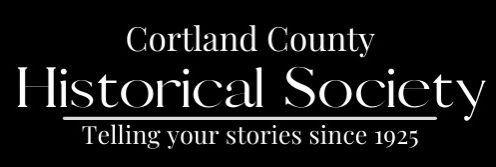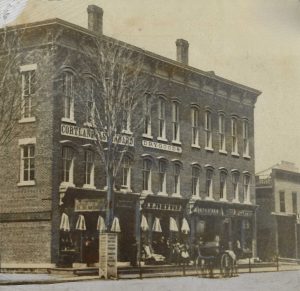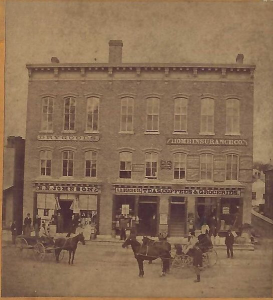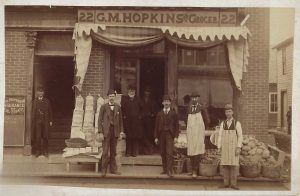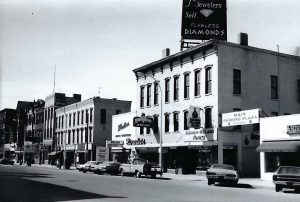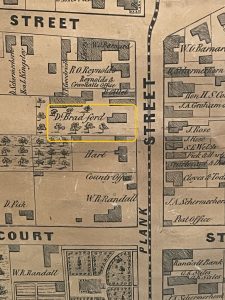 The history of numbers 22-28 Main Street in Cortland, like several other addresses previously covered, starts with a house. Sylvester Blair (-1836) built his home on the property “consisting of a large and advantageously situated village lot” with a brick house, neighboring brick store (what would be no.18), extensive out buildings and well selected orchard. Blair was partnered with his brother-in-law, Asahel Lyman, in the mercantile business and in 1829 originated a pottery establishment located on the corner of Graham and Groton Avenues. Unfortunately, he did not have long to enjoy success for he died of fits (a seizure) in 1836 while traveling on a steamboat called DeWitt Clinton in New York City.
The history of numbers 22-28 Main Street in Cortland, like several other addresses previously covered, starts with a house. Sylvester Blair (-1836) built his home on the property “consisting of a large and advantageously situated village lot” with a brick house, neighboring brick store (what would be no.18), extensive out buildings and well selected orchard. Blair was partnered with his brother-in-law, Asahel Lyman, in the mercantile business and in 1829 originated a pottery establishment located on the corner of Graham and Groton Avenues. Unfortunately, he did not have long to enjoy success for he died of fits (a seizure) in 1836 while traveling on a steamboat called DeWitt Clinton in New York City.The estate was sold to Stephen Moody (1798-1850) then to Daniel Bradford in 1846. Bradford appears to have resided in the home and conducted a bookstore/dry goods in the brick store next door at no.18 until he moved into the old building across the way at no.9 around 1865. Two short years later, the residence would be gone to make way for the Masonic Hall Block built by Hiram J. Messenger. The block encompassed the businesses of E.N. Johnson (dry goods), S.D. Beach (groceries), and insurance offices on the second floor. The third floor was dedicated to the Masonic fraternity and included a banquet hall, lodge rooms, and various other ante rooms housing regalia. Aside from the Freemasons, over the years the upstairs rooms were also used by the Order of Eagles and by the VFW.
One year after the Masonic Hall Block was constructed, in 1868, another section was added to the structure at no.28, and although the front made it appear as though it had been all built as one block, it was referred to separately as the Moore Block. The Tanner Bros. sold their dress and fancy dry goods out of the storefront on the first floor, while the Cortland Standard operated above.
In 1870, we see the first mention of Moore Street later called Orchard Street. The Josiah Hart residence had been demolished making way for the development of this street named first for R.R. Moore who owned the property, then renamed after the fine orchards that remained from the Blair/Bradford and Hart estates.
On February 14, 1877, a fire said to be the most destructive since that of the Eagle Tavern in 1862 broke out above E.N. Johnson’s store that destroyed much of the interior and contents of the block. Businesses were returning to the block the following year, including the Sherwood Bros. who operated their grocery before and after the fire in no.22. There were several other fires over the years, including the time a spark from a rocket let off during the celebration at the end of WWI on November 11, 1918 flew through a window on the second floor and set fire to some bedding. Nonetheless, this block did not experience the same devastation that so many other structures on Cortland’s Main Street underwent.
In 1886, Alden M. Jewett established his jewelry business which he kept in no.26 until 1920. In fact, the spot would serve as a jewelry store for over 100 years except for a short three years in the 1960s. Jewett’s was followed by the Andrews Brothers. Louis Fiorentini worked at Andrews’ while attending college in Morrisville, and would return to the address with his own jewelry business in 1963. Several years prior, the Fiorentini’s purchased the building. McGraw & Elliot Drug store had a three-year lease in no.26, but once they vacated the Fiorentinis remodeled the store back into a jewelry store which was open until 2008.
Another long-time business was Mullen Wall Paper & Stationary in no. 28. The business first occupied the spot in 1915 opened by brothers Frank and Charles Mullen. Two further generations of the Mullen family would keep the business going, making necessary changes to the building in the years 1958-1965 that included a 110-foot addition added to the rear and then the removal of the third floor that was in disrepair. After 105 years on Main Street, Mullens Office Outfitters closed in 2018.
This block has also been referred to as the Sugarman Block, the first reference by this name appearing about 1899. While that name seemed to stick, it also appears in city directories to have been called the Empire Block or Empire Building starting in 1906. After the Fiorentinis purchased it, the name changed once again to the Fiorentini Block. The multiple different names did make research a bit tricky!
As usual, it’s nearly impossible to mention every business, person, and event associated with these addresses, for there have been numerous tailors, furniture stores, 5 & 10 cent stores, real estate agents, dentists, and more that set up shop! Perhaps you might remember Dean Phipps Auto Store located in no.22 between the 1940s-1960s. Or Sherwin-Williams Co (22), and Harts & Flowers (24) from the 1970s. Do you have memories of any of these businesses?
